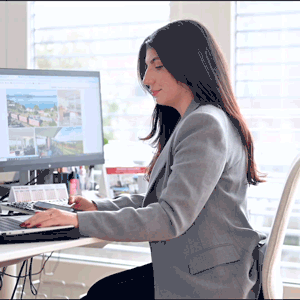In view of the high demand, many people think that their property will sell quickly even with poor photos. However, poor photos often lead to unnecessary viewings where prospective buyers say: "I imagined it differently." You will also be better able to push through the price of the property if the positive impression from the photos is confirmed on site. Rule of thumb: the better the photos, the easier it is for prospective buyers to decide whether your property is suitable for them.
The overall impression counts! We know it from the advertising and food industry: less is often more. Photos of properties look better if they make a "tidy" impression. If rooms are cluttered, it disturbs the imagination of prospective buyers and makes it difficult for them to see their future home. Experts advise: If you take photos of furnished rooms or the garden and yard, these should be "depersonalised". In other words, private objects such as clothing, toothbrushes, lawnmowers or similar items should not be visible in the photo. Test photos are recommended to discover such disturbing little things.
Bright rooms are just as important for convincing property photos. Drawn curtains or blinds and backlighting darken rooms and exterior views of a property. Bright rooms are more inviting. However, if the blazing sun shines into the room, photos will be overexposed. It is therefore advisable to choose the exact time when the light is ideal. In such cases, however, curtains or blinds can also be used to provide optimum light. With a professional camera, the amount of light can be regulated using the aperture and shutter speed.
However, a good photo of your property also depends on the perspective. If it is chosen incorrectly, the house or rooms can appear distorted or the proportions incorrect. If a room appears smaller than it actually is, potential buyers may be put off. The lens also plays a role here. If you want to get as much space as possible in the photo, wide-angle lenses make sense. However, a wide-angle lens can also make rooms appear too large. This can lead to unnecessary viewings where prospective buyers realise that your property is too small after all. It is also important to ensure that no lines fall. This leads to spatial distortions. To obtain straight lines, for example at the corners of walls, doors or windows, the camera should be held straight. It is advisable to take the photo from a height of around one metre.
If, in the end, small details in the photo are still not right, they can be slightly reworked. If lines are not perpendicular, you can adjust, rectify and straighten the picture a little. You can also slightly increase the brightness and contrast of photos that are too dark. But be careful not to overdo it with the enhancement. If prospective buyers see that the photo is too heavily edited, they might become sceptical.
Don't have time for this kind of effort? Or do you have questions about how to take perfect property photos? Get in touch with us! We'll take care of it for you.
Photo: KatarzynaBialasiewicz









